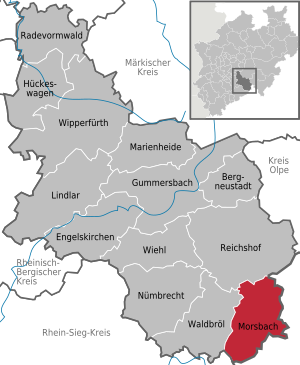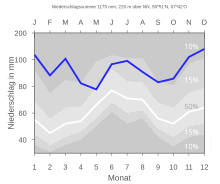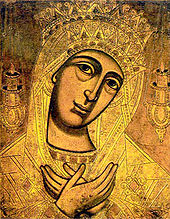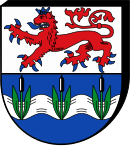Morsbach
| coat of arms | Germany map | |
|---|---|---|

|
Coordinates: 50 ° 52 ' N , 7 ° 43' E |
|
| Basic data | ||
| State : | North Rhine-Westphalia | |
| Administrative region : | Cologne | |
| Circle : | Oberbergischer Kreis | |
| Height : | 220 m above sea level NHN | |
| Area : | 55.96 km 2 | |
| Residents: | 10,138 (Dec. 31, 2019) | |
| Population density : | 181 inhabitants per km 2 | |
| Postal code : | 51597 | |
| Area code : | 02294 | |
| License plate : | GM | |
| Community key : | 05 3 74 028 | |
| LOCODE : | DE MBH | |
| Address of the municipal administration: |
Bahnhofstrasse 2 51597 Morsbach |
|
| Website : | ||
| Mayor : | Jörg Bukowski ( independent ) | |
| Location of the community of Morsbach in the Oberbergisches Kreis | ||
Morsbach is a municipality in the Oberbergisches Kreis in North Rhine-Westphalia on the border with Rhineland-Palatinate .
geography
Geographical location
Morsbach is located in the Oberbergisches Land, in the extreme southern end of the Oberbergisches Kreis.
climate
| The annual precipitation is 1175 mm and is therefore in the upper tenth of the values recorded by the measuring points of the German Weather Service . Over 92% indicate lower values. The driest month is May; it rains most in December. In the wettest month there is around 1.8 times more rain than in the driest month. The seasonal fluctuations in precipitation are in the upper fifth. In over 85% of all places, the monthly precipitation fluctuates less. |
Neighboring communities
| Reichshof | ||
| Waldbröl |

|
Friesenhagen |
| Windeck | Knowledge | Birch honey meal |
Community structure
The community is divided into the following 66 districts:
| A. | Alzen - Amberg - Appenhagen |
| B. | Berghausen - Birken - Birzel - Bitze - Böcklingen - Breitgen - Volperhausen Castle |
| E. | Ellingen - Erblingen - Euelsloch - Eugenienthal |
| F. | Flockenberg - Frankenthal |
| H | Hahn - Halle - Heide - Hellerseifen - Herbertshagen - Höferhof - Holpe - Hülstert |
| K | Katzenbach - Kömpel - Korseifen |
| L. | Ley - Lichtenberg - Lützelseifen |
| N | Neuhöfchen - Niederasbach - Niederdorf - Niederwarnsbach - Niederzielenbach |
| O | Oberasbach - Oberholpe - Oberwarnsbach - Oberzielenbach - Oil mill - Ortseifen |
| R. | Reinshagen - Rhein - Knights soaps - Rolshagen - Rome - Rose Garden - Rossbach |
| S. | Schlechtingen - Seifen - Siedenberg - Solseifen - Springe - Steimelhagen - Stentenbach - Stockshöhe - Straßerhof - Strick |
| U | Überasbach - Überholz |
| V | Volperhausen |
| W. | Wallerhausen - Wendershagen - Wittershagen |
| Z | Zinshardt |
Waters
In the central town of Morsbach, the Morsbach and the Wisser Bach flow together.
history
The first settlement of the Morsbach area goes back to the Neolithic Age , which can be proven by a stone ax and the fragment of a flint blade.
Morsbach was first mentioned in documents at the end of the 9th century. Around 800, under Charlemagne , the empire received a new district constitution and thus the first measurable territorial division. The parish of Morsbach was then part of the Auelgau (Sieggau) and was administered by a count. Territorial lords in the parish of Morsbach were the Counts of Sayn . Morsbach is mentioned for the first time in a document in the early medieval register of the possessions of the canons of St. Cassius and Florentius in Bonn. A little later, Morsbach was mentioned in a real estate directory of the Diocese of Cologne (liber valoris) showing the conditions at that time. Morsbach is the oldest documented place in the Oberbergischer Kreis.
On March 31, 1131, Pope Innocent II confirmed the possession of the Morsbach Church and part of the tithe ( ecclesiam Moresbach cum parte decimae ) to the Cassius Foundation in Bonn . In 1174, the Counts of Berg received from Landgrave Heinrich Raspe III at Schloss Burg an der Wupper . of Thuringia Windeck Castle on the Sieg as a fief.
The Saynian office of Nümbrecht, consisting of the parishes of Nümbrecht, Waldbröl and Morsbach, became the independent imperial rule of Homburg in 1276, with its own constitution and administration. In 1311 the Counts of Sayn-Homburg recognized the court rights in the parish of Morsbach, the fishing rights and the tithe of the Böcklingen copper mine as property of the Counts of Berg. The county of Berg was elevated to a duchy by the Roman-German King Wenceslaus in 1380 . The royal seat was Düsseldorf.
Around 1400 about half of the Homburg parish of Morsbach with its main town became the property of the Dukes of Berg. The borders were described in "Weistümern" from 1464 to 1572 and mapped out in 1575 in the so-called Merkatorkarte. The "Eigenhumb Moirsbach" belonged to the Windeck office . Thus the parish of Morsbach was split into a Bergisch and a Homburgisch area (main town Holpe). Around 1500 a chapel was built in Holpe as a branch church of Morsbach.
In 1563 the Counts of Sayn-Homburg issued a Lutheran church ordinance for their area and declared the new doctrine to be the state religion. Thus the parish of Morsbach was denominationally divided into the Catholic district Morsbach and the Lutheran district Holpe.
Through the " Siegburg settlement " on June 12, 1604, the Homburg part of the area also came to the Duchy of Berg and the Office of Windeck. The parish became a political unit again with around 1,100 inhabitants. In 1614 (finally 1666) the Duchy of Berg came to Pfalz-Neuburg (Wittelsbacher). In 1634 the parish of Morsbach became the fiefdom of Count Hermann von Hatzfeldt (Lord of Wildenburg and Crottorf), but was taken back in 1661 by Philipp Wilhelm von Berg. This gave the Morsbachers the right to fish and hunt, their own mayor and their own lower court (7 Scheffen) after the "high court of Windeck".
In 1742, Elector Karl Theodor zu Pfalz-Sulzbach became Duke of Berg. As Elector of Bavaria (from 1777) he moved the residence of the duchy to Munich. In the war of the allied European monarchs against the French revolutionary army, the French advanced across the Rhine, occupied the Duchy of Berg in 1795 and camped in Morsbach. In 1805, the successor to Elector Karl Theodor, Elector Maximilian Joseph von Pfalz-Zweibrücken, allied himself with Napoleon and became King of Bavaria. A year later, Bavaria ceded the Duchy of Berg to France. Berg became the Grand Duchy and Joachim Murat (Napoleon's brother-in-law) his regent. As early as 1808, however, the Grand Duchy fell back to Napoleon and a new administrative division was established. Morsbach became the mayor's office ( Mairie ) in the canton of Waldbröl, which belonged to the Arrondissement Siegen (prefecture in Dillenburg) and thus to the Département Sieg . From January 1, 1810, French law applied in the Generalgouvernement of Berg, most of which remained in force until 1870 or 1900. From 1813 to 1815 the Generalgouvernement - after the expulsion of the French - was provisionally administered and redistributed by a Governor General ( Justus Gruner ). Morsbach became a municipality in the canton of Waldbröl and belonged to the Wipperfürth district directorate . In 1816 this administrative division was changed again. The mayor's office in Morsbach then belonged to the Waldbröl district in the Cologne administrative district and thus to the Kleve-Jülich-Berg province (from 1822 Rhine province ).
On October 1, 1932, the Waldbröl and Gummersbach districts were merged to form the Oberbergischer Kreis . The municipality of Morsbach, the borders of which had remained almost unchanged for centuries, had around 5300 inhabitants at that time.
After the Second World War , the area came under American occupation (April 8 - June 17, 1945), then (until February 20, 1949) under British or Belgian occupation. Since 1946 the Oberbergische Kreis and Morsbach have been in the newly formed state of North Rhine-Westphalia .
In 1995 the Morsbach community celebrated its 1100th anniversary with a historical pageant.
Morsbach's special role as a predominantly Catholic community in an evangelical environment for a long time is reflected in the popular attribution of "the republic".
Religions
The residents of Morsbach are 53.33% Catholic and 24.29% Protestant. 22.38% of the population belong to other or no denominations. The following parishes exist in the parish or in individual localities:
- Catholic parish St. Gertrud, Morsbach with the churches, Basilica St. Gertrud and the Herz-Mariä-Kirche (Alzen)
- Catholic parish Christ König, Ellingen
- Catholic parish of St. Mary's Visitation, with the churches of St. Mary's Visitation (Holpe) and St. Antonius (Volperhausen) .
- Catholic parish of St. Joseph, Lichtenberg
- Evangelical parish of Holpe-Morsbach
- Free church in Morsbach eV in the Steimelhagen district
Population development
| year | 1838 | 1866 | 1925 | 1939 | 1950 | 1960 | 1967 | 1972 | 1980 | 1984 | 1990 | 2000 | 2002 | 2003 | 2004 | 2005 | 2006 | 2012 | 2013 |
|---|---|---|---|---|---|---|---|---|---|---|---|---|---|---|---|---|---|---|---|
| population | 3,563 | 3,857 | 5,293 | 5,685 | 6,994 | 7.155 | 8,283 | 9,689 | 10,669 | 10,565 | 10,366 | 12,250 | 12,337 | 11,621 | 11,559 | 12,296 | 11,486 | 10,435 | 10,236 |
politics
Municipal council
- Results of the past four municipal council elections
| Party / list | 2014 result | Result 2009 | 2004 result | Result 1999 | |||
| Share of votes | Seats | Share of votes | Seats | Share of votes | Seats | Share of votes | |
| CDU | 36.3% | 9 | 32.9% | 10 | 46.9% | 14th | 47.35% |
| SPD | 27.6% | 7th | 26.8% | 9 | 18.7% | 6th | 18.69% |
| Green | 7.2% | 2 | 5.7% | 2 | 4.2% | 1 | 2.79% |
| FDP | 4.5% | 1 | 9.6% | 3 | 7.9% | 2 | 4.56% |
| UBV / UWG | 5.8% | 2 | 5.9% | 2 | 9.4% | 3 | 18.79% |
| Citizens' Movement for Morsbach (BFM) | 18.5% | 5 | 19.2% | 6th | 12.9% | 4th | 7.8% |
| Others | - | - | - | - | - | - | 7.62% |
By reducing the number of electoral districts and due to the lack of overhang mandates, the municipal council reduced itself in 2014 from 32 to 26 seats. As a result, the CDU and SPD lost mandates despite the gains in votes. The turnout in 2014 was 55.5% (2009: 59.4%).
mayor
Mayor of the community from 2004 to 2009 was Raimund Reuber (CDU). Supported by UBV and UWG, he won the 2004 election with 54.6%. His non-party opponent, supported by the SPD, FDP, Greens and BFM, received 45.4% of the vote.
The non-party candidate Jörg Bukowski was elected the new mayor in 2009 with 70.7%. His candidacy was supported by the parties represented in the council, the SPD, BFM, FDP, UBV and Alliance 90 / Greens. His opponent from the CDU received 29.3% of the vote. In 2014, Bukowski was confirmed in office with a score of 71.67%.
coat of arms
The coat of arms shows a striding red, blue-tongued, blue-clawed and blue-crowned Bergisch lion on a silver background in the upper field of the horizontally divided shield. The Bergisch lion is the heraldic animal of the former Duchy of Berg . Today many communities, cities and districts located there still have it in their coat of arms, including Morsbach. The lion is a common figure in heraldry and the most popular heraldic animal. He symbolizes courage and royalty, as he is considered the king of animals.
In the lower field, a silver stream with black markings in the bends and three black bog bulbs , each with two green leaves and a green stem, can be seen on a blue background . The bog pistons and the stream indicate the wet biotope with swamp and moor areas and a stream that used to be located in the valley of today's town hall and the spa park and probably gave the community its name "Morsbach". In this respect, the coat of arms is talking .
Parish partnership
- Morsbach maintains a town partnership with Milly-la-Forêt , (in the French department of Essonne ) .
Culture and sights
Morsbach Community Culture Association (GKV)
The Morsbach Community Culture Association is an amalgamation of all cultural associations in the Morsbach community. The GKV now has 26 associations in which over 1200 people are active.
theatre
- Theater and Amateur play group of the Heimatverein Morsbach eV
Buildings
- The Romanesque gallery basilica of St. Gertrud dates from the 12th / 13th centuries. Century.
- Volperhausen Castle .
- From the observation tower on the Hohen Hardt ( 338.9 m above sea level ) - tower height with transmitter 45 m; Altitude 329 m - the view extends to the Siebengebirge near Bonn .
- The mining history of Morsbach is documented by the protected tunnel of the Magdalena mine in the Rossenbach valley. The 2050 m long "deep Magdalena tunnel" was opened in 1890 and remained in operation until 1912.
Economy and Infrastructure
traffic
Various bus lines from OVAG and Ochsenbrücher GmbH connect the Morsbach districts with the surrounding communities such as Waldbröl and Wissen (Sieg) . At the weekend, alternative forms of operation such as taxi buses (only by prior arrangement) are used. The bus station in the center of Morsbach acts as the central transfer point . The collective tariff of the Verkehrsverbund Rhein-Sieg (VRS) and the tariff of the Verkehrsverbund Rhein Mosel (VRM) apply
- Line 276A: Morsbach - Friesenhagen - Freudenberg (VRM)
- Line 304: Morsbach - Denklingen - Wiehl - Bielstein - Dieringhausen - Gummersbach (VRS)
- Line 340: Morsbach - Holpe - Waldbröl (VRS)
- Line 347: Morsbach - Wissen (VRM)
- Line 349: Morsbach round trip (VRS)
The terminus of both sections of the Wissertalbahn is located in Morsbach . While the section to Wissen (Sieg) was dismantled in the 1950s after destruction in the Second World War, the other section continues to Hermesdorf and on to Waldbröl to this day . The route, which was heavily overgrown until 2009, has now been uncovered and prepared by volunteer railway enthusiasts; The long-term plan is to start a museum railroad here .
Despite a court order that ensures rail operations on the line for at least 50 years, the community of Morsbach continues to defend itself against the railways with all possible means. For example, the municipality once had a non-standardized buffer stop welded onto the route at Morsbach-Kömpel, whereupon it was reported because of a dangerous interference in rail traffic .
As in the entire Bergisches Land, almost all of Morsbach's hiking trails were laid out by the Sauerland Mountain Association (SGV) . Supraregional hiking trails that run through Morsbach are the Lenne-Sieg-Weg (X11) and the Richard-Schirrmann-Weg (X12). These trails and the local hiking trails are listed in detail in the article Hiking trails in the Oberbergisches Land . The youth hostel in Morsbach offered hikers, groups and families a total of 161 beds and several leisure facilities. The youth hostel was closed permanently in 2018 due to deficiencies in fire protection that could not be remedied.
media
In addition to the community library, there is a Catholic and a Protestant public library in Morsbach.
education
The following educational institutions are in Morsbach:
- Community elementary school Morsbach, formerly Franziskusschule - Catholic elementary school Morsbach
- Community elementary school Lichtenberg
- Holpe Community Primary School
- Leonardo Da Vinci School Morsbach (secondary school)
- Music School Morsbach eV
- Morsbach department of the Oberberg community college
economy
In Morsbach there is a wide range of small and medium-sized businesses. The industries with the highest employment figures are plastics processing (42% of employees), the service sector (19%) and construction (14%). In the economic history of Morsbach, ore mining for iron ores as well as zinc, lead and copper ores played a major role until the 1920s. The largest pit "Georg und Sonne" was in the Steimelhagen district .
Personalities
Honorary citizen
- Karl Strack (1884–1975), born in Alzen, was a Catholic dean.
Sons and daughters of the church
- Rolf Birkhölzer (* 1949), football player
- Harald Elster (* 1952), President of the German Association of Tax Consultants
- Heinrich Halberstadt (1875–1944), local politician
- Paul-Walter Schäfer (1921–2009), evangelist, evangelical pastor, author, radio preacher
literature
- Christoph Buchen: Morsbach - in the Bergisches Land nature park. sn, Gummersbach 2004, ISBN 3-9806036-8-7 (color picture book).
- Christoph Buchen, Erwin Weber: Alt-Morsbach. The Morsbach community in old pictures. (= Morsbach. Heimatchronik series. 1). Meinerzhagener printing and publishing house, Meinerzhagen 1981.
- Catholic parish Holpe (Hrsg.): 100 years parish church of St. Mary Visitation Holpe. Holidays 20-26 September 1999. Holpe Catholic Church Congregation, Holpe 1999.
- www.lok-report.de (October 18, 2008): North Rhine-Westphalia: Dangerous interference in rail traffic by the municipality of Morsbach.
- Municipality of Morsbach (Ed.): Morsbach. Chronicle of a community in Oberberg (= Morsbach. Heimatchronikreihe. 2). MD & V Meinerzhagener Druck- und Verlags-Haus, Meinerzhagen 1987, ISBN 3-88913-114-X .
- Morsbach municipality (ed.): 1100 years of Morsbach. 895–1995 (= The history of the community of Morsbach. Vol. 3). Morsbach community, Waldbröl 1995, ISBN 3-9802690-5-1 .
- Johannes Schlechtingen (Red.): Chronicle of the Lichtenberg School. Friends of the Lichtenberg Primary School, Morsbach 1996.
- Michael Schmitz: Euelsloch. On the development and situation of a hamlet in the municipality of Morsbach. At the same time a general contribution to the development of hamlets in Morsbach. Dorfgemeinschaft Euelsloch eV, Euelsloch 1995, ISBN 3-9802690-6-X .
- Michael Schmitz, Manfred Schausten: "Pack your swimming trunks ...". Swimming and bathing in the southern Oberbergischer Kreis and in the northern Altenkirchen district in the 20th century. Pictures, documents, reports and investigations from Morsbach, Birken-Honey Essen, Wissen, Katzwinkel, churches ("Tüschebachs Weiher"), Friesenhagen, Reichshof, Wiehl, Nümbrecht and Waldbröl. Galunder, Nümbrecht-Elsenroth 2002, ISBN 3-89909-008-X .
- Karl Simon with the collaboration of Josef Breuer and Fritz Mylenbusch: The Oberbergische Kreis. A local reading and work book for school. City of Gummersbach, Gummersbach 1968.
- Hermann Vogler: Geological maps of North Rhine-Westphalia. 1: 25000 / sheet 5112, Morsbach 1968, geological map.
Web links
Individual evidence
- ↑ Population of the municipalities of North Rhine-Westphalia on December 31, 2019 - update of the population based on the census of May 9, 2011. State Office for Information and Technology North Rhine-Westphalia (IT.NRW), accessed on June 17, 2020 . ( Help on this )
- ^ Website of the Morsbach community election portal: Council election 2014 community
- ^ The State Returning Officer of North Rhine-Westphalia, MUNICIPAL ELECTIONS 2014, final result for Morsbach
- ↑ OBK election results
- ↑ Map services of the Federal Agency for Nature Conservation ( information )
- ↑ The "Eiffel Tower of Morsbach" turns 50 on the website of the municipality of Morsbach, accessed on December 17, 2015
- ↑ Morsbach closes the railway line, railway fans angry Oberberg-Aktuell
- ↑ https://www.rundschau-online.de/region/oberberg/morsbach/maengel-im-brandschutz-aus-fuer-jugendherberge-in-morsbach-ist-besiegel-31770666








